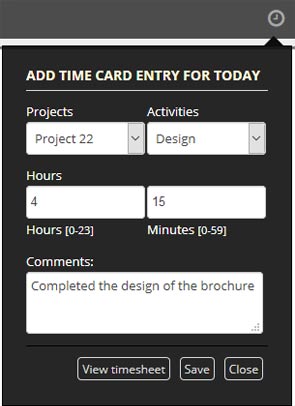“Time is Money.” You must have heard this popular saying before. It clearly indicates that the real cost of poor time management is more than a billion dollars. It leads to performance issues and affects overall business productivity.
What is the solution to this problem? Is there a way to motivate people to change their poor time management habits? Read on.
Timesheet management is a smart way to track employee time and project-related tasks. Experts say that timesheets are often misunderstood. In a survey conducted by Replicon, participants were asked to name a time tracking progress which is disliked by their employees. Surprisingly, more than 70 percent survey respondents named timesheets as the most loathed activity at their workplace. Expense reporting, paid time off and other time tracking activities were named by 18%, 8% and 4% respondents respectively. Employees feel micromanaged when asked to give a brief about every hour spent at the workplace.
However, managers believe that filling timesheet is imperative for:
- » measuring employee productivity
- » managing time on schedule
- » ensuring accurate payroll
Timesheets are used for productivity analysis, especially for white-collared workforce. Experts believe that the concept of timesheet works best in a culture where success is measured by results, and not by number of hours people spend sitting in their work desks.
Reasons for Using Timesheets

Identify time spent on a task
Peter Ducker, an Austrian-born author and educator, has rightly said, “Until we can manage time, we can manage nothing else.”
When analysing timesheets, average time spent to do a specific task can be estimated. This is a valuable data for a team that needs to perform same tasks repeatedly. Managers can use this employee time tracking data for better planning of resources.
For instance, let’s say there is a team of 5 freelance writers and each person spends 3 hours to write an article. If the team needs to publish 12 articles in a week for a client, then the manager has enough data to analyse and create a well-thought, more accurate project schedule.
Increase efficiency of subordinates
Maintaining timesheets regularly give insights on where employees are spending their time and effort. People do not notice, but water-cooler conversations, personal phone calls, social media and other reasons keep them away from work. This reduces efficiency in work.
Timesheets identify the performance gaps. Once pointed out, employees can cut down time spent away from work desk and speed up their work to meet performance standards.
Estimate accurate project time limit
Timesheet is an indispensable tool for managers. They can use the tool to estimate the actual time spent by an employee on projects of a certain type. This information is crucial to have a more accurate estimate on the total time needed to complete next project of the same kind.
Measure and reduce workload
Time tracking is not about putting employees under 24×7 surveillance. In fact, it helps in identifying overworked employees. With the information available in timesheets, managers can reduce the work pressure from their subordinates, either by putting more colleagues on the team for support or hiring new people or freelancers on contract basis.
Accurate client billing
In a client-facing business, it is important to assure clients that their money is not being wasted and the project is handled effectively and productively. Employee timesheets is a great way to reassure clients on the progression of the project. It becomes easy to justify all invoices as the client can see complete record of total billable work hours spent on project-related tasks.
Timesheets provide details that can be used to spell out exactly what an employee did on a project.
Observe progress on the project
When clients get to see employee timesheets regularly, they get a fair idea on real-time progress of the project and daily tasks performed to complete it. This eliminates the need for a client to repeatedly write emails to know the status of the project.
Motivate Employees to Fill Timesheets Regularly
Employees dislike and resist filling timesheet every day, whereas managers use it extensively for project scheduling. One of the biggest concern for a manager is if subordinates find it daunting and time-consuming to fill timesheets. Overcoming the resistance to use timesheets can be challenging for the manager, but not impossible.
A good way to do employee time tracking is by implementing timesheets from top to down. When CEO, managers and other seniors fill the same timesheet each day, the employees feel equality at the workplace. It shows that favouritism doesn’t exist, and everyone is treated equal.
Employees often perceive timesheets as a tool for micromanagement. It is suggested to deal with this concern. Take out time and sit with the team members to explain the purpose behind implementing timesheets. Tell them that micromanagement is a myth associated with employee time tracking, and convince them to believe in your vision.
If your team is resistant to the idea of filling timesheets and complain it to be a workload, then provide them an online timesheet management software. Demonstrate to them how easy it is to fill the daily work record in just few clicks. Filling online timesheets is like any other quick task you do. It is as simple as clicking and uploading a picture on Instagram or Facebook. It takes less than 1 minute.

A final thought…
Filling timesheets isn’t a favourite thing to do, especially at the end of a long tiring day. However, they must be used to get more accuracy in the billable work hours, avoid the need for tedious manual calculation of an employee’s working hours/ days, increase employee satisfaction, provide meaningful insights into future manpower requirement, and save time in simplifying project management for a team.








